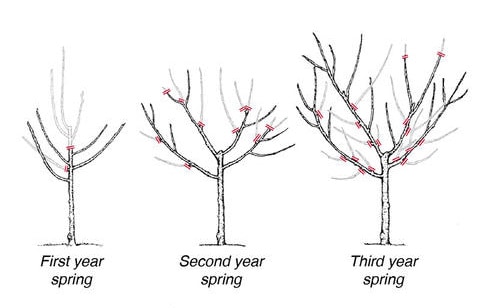There is almost nothing as wonderful as the taste of fresh, tree-ripened peaches on a warm afternoon. With the sweet juice running down your chin and the buzz of insects around, if you have not experienced this, then you need to plant some peach trees.
Here in the Central Great Plains, peaches can be difficult to fruit reliably because of late spring freezes. However, they are more than just a fruit tree, having great ornamental appeal as well. But the fruit is worth waiting for.
I have been around peach trees my whole life, even though it took moving to Northeast Kansas to know about the commercial aspect of growing them. Once I started at Grimm’s Gardens, I got my first taste of commercial production (on a small scale) as well as how much work it takes to maintain 100 peach trees.
Cultivars of Peaches
One of the best things about growing peaches is that they do not need a pollinator to produce fruit. And what is a pollinator? This is another cultivar with similar bloom times that provides pollen for insects to transfer from one tree to another, increasing fruit yield and size.
Peaches can be grown singly or in groups within the landscape or orchard. You can start with a single tree and build a whole fruit tree guild around it, making the peach tree your centerpiece.
When choosing the peach tree(s) for your own garden or orchard, bear in mind the following criteria: rootstock, size, ripening time, insect or pest resistance, use, and taste.

Rootstocks
What are rootstocks and how do they affect my trees? Rootstocks are the roots of the tree which the fruit bearing top is grafted onto. With peach trees, you do not need a rootstock, but can plant trees from seed. Peaches grow true from seed in most cases. However, most commercially available trees are grown on rootstocks to limit the size of the overall plant and promote the best varieties. They are also chosen to be resistant to rootknot nematodes, and for cold hardiness.
Dwarf standard rootstocks keep trees back to 25% of height potential. Most trees on these rootstocks will mature at 6 to 12 feet tall. However, these are the least cold tolerant and often will not grow in zones lower than 7.
Semi-dwarf rootstocks grow to 40% to 60% of height potential and trees mature between 10 and 20 feet tall. These are the most used rootstock for Zones 4 to 7 and are best for the Central Great Plains.
Standard rootstocks keep trees growing at full height potential and most peach trees mature between 20 and 40 feet tall. They are the hardiest rootstocks.
Peach Varieties for the Central Great Plains
There are many wonderfully tasting peach varieties out there. However, not all will do well in our extreme climate. Over the years, I have seen many gardeners fail at growing peaches because they do not pick either cultivars or rootstocks hardy for our region.
- Early Elberta – ripens in mid July, great for fresh eating, canning, or freezing.
- Redhaven – ripens July to August, great for canning, freezing, and fresh eating.
- Burbank July Elberta – ripens late July, and is good for fresh eating, canning, or freezing.
- Contender – ripen s in mid August and is good for fresh eating, canning, and freezing.
- Flamin’ Fury Jumbo – has very large fruit, ripens in early August and is excellent for fresh eating, canning, and freezing.
- Belle of Georgia – a white fleshed peach that ripens in August and is best for fresh eating.
Siting and Planting Peaches
Where to plant your peach trees is determined by the overall layout of your property and the amount of shade producing trees or structures on it. Peaches prefer full sun, but can also take limited shade (usually early morning or later afternoon shade). If you live on a hillside, try to put your trees near the top of the hill or away from low-lying areas where frost pockets can develop.
What are frost pockets? They are small, low-lying areas where frost is more likely due to poor drainage or poor air movement.
Peach trees should be planted 15 to 30 feet apart from each other, depending on rootstock or size potential of the tree. If you are planning to keep your trees well pruned and they are on semi-dwarf rootstocks, 15 feet apart would be fine.
Digging the Hole, Watering, and Mulching
Just like other trees, planting is one of the most important steps to get right the first time. Peach trees should never be planted too deep, or you risk suffocation of the cambium (inner bark area) from moisture which collects along the bark when it touches soil.
Dig your hole to the depth of the root ball of the tree (not the container it is in), and just slightly wider than the root ball (5-15%). Do not amend the soil with anything. If you are planting trees from a plastic container, it may be necessary to cut the root ball into a square shape with a sawzall. This helps eliminate circling and girdling roots which will kill the tree later on.
Place the root ball in the hole and backfill with the soil you took out. Tamp down gently with your hands and then water the tree. Fill the hole with water until is runs out, then let it settle and add more soil if necessary. Mulch with an organic mulch such as wood chips, chopped alfalfa, or sawdust, keeping the mulch 1 to 3 inches away from the trunk.
Staking Your Peach Trees
I recommend all first year peach trees to be staked, at least for 1 year after planting or until the root ball sends out new roots and has stabilized in the soil. For trees 1 inch in diameter or less, a single fiberglass or wood stake should be sufficient. Angle the stake at a 60 degree down angle against the trunk of the tree and into the soil 1 foot. Tie the stake to the tree with a rubber tree tie or piece of burlap, with the tie between the trunk and the stake.
If you live where rabbits or deer are present, it will be necessary to wrap the bark of the tree each fall with tree wrap or a plastic tube to protect the young bark. Do this until the bark has started to split open on its own (about 4 years old). To keep deer away from the trees, stake 2 x 4 inch wire mesh fencing 3 to 5 feet in diameter away from the tree until it is big enough to sustain light grazing (3 to 5 years old).
Pruning Peaches
Every winter I get to prune the peaches. This can be a scary task for someone who is not used to pruning them. Most clients tell me they are afraid to try it. But it is not as hard as they think. There are 3 main things to do when pruning peaches.
- Open up the center when the tree is young by removing the central leader and selecting 3 to 5 scaffold branches for the main branches of the tree. Also, after the first year, remove any branches going straight up or towards the center of the tree.
- Remove suckers, watersprouts, and dead. This is done yearly, but can also be done in summer if you have time.
- Cut back fruiting branches. Remove 6 to 18 inches of the previous season’s growth to limit flowering and strengthen branching.

Pests and Diseases
I have gone more in depth into various diseases and insect pests of peaches and other stone fruits. Find that information by clicking here. Peaches, though fairly easy to grow and manage, do have quite a few insect pests and diseases that make it difficult. But once you learn the pest, then you can learn how to best manage them.
Insect Pests of Peaches
The pests in red are included in the problems of stone fruits guide in the other post. All others are present, but may not be a big issue in this region.
- Green June beetle
- Japanese beetle
- Oriental fruit moth (OFM)
- Spotted Wing drosophila (SWD)
- Peachtree borer
- Brown marmorated stink bug (not yet an issue in the Central Great Plains)
- Plum curculio
- Green fruitworm
- Oblique-banded leafroller
- Stink bugs
- Tarnished plant bugs
- American plum borer
- Aphids
- Peach twig borer
- San Jose scale
- Rose chafer
Diseases of Peaches
- Peach Leaf Curl
- Brown rot
- Bacterial canker
- Texas root rot
- Rootknot nematodes (most rootstocks are resistant)
- Bacterial spot
- Crown gall
- X-Disease

Conclusion
Peaches can be a wonderful addition to the yard and garden. Fruit trees of any kind can help lower your grocery bills, or just provide you with a healthy, living landscape that you can enjoy visibly and by eating of its fruit. Enjoy life and plant a peach tree.
Happy planting!




